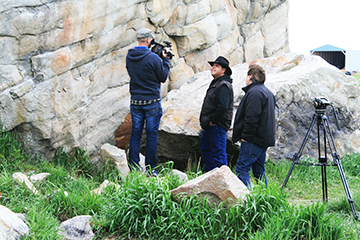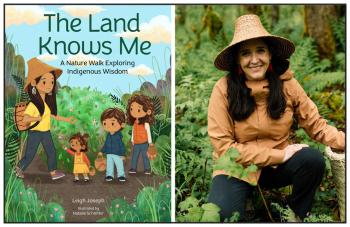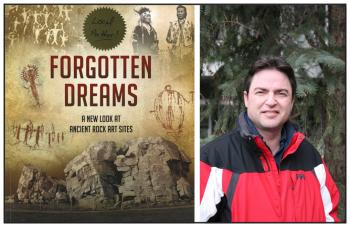Author introduces children to their plant relations and what makes up a healthy ecosystem
Image Caption
Windspeaker.com Books Feature Writer
Local Journalism Initiative Reporter
Both on the page and in real life, Leigh Joseph is giving her children an opportunity that wasn't there for her grandparents.
As the characters in her first children's book, The Land Knows Me: A Nature Walk Exploring Indigenous Wisdom, Joseph takes her son, daughter and niece through the Pacific northwest rainforest, and in a respectful way introduces them to their relations, the plants and everything, like pollinators, that makes an ecosystem healthy.
“It's been really important, since I've had kids, as I reflected on the fact that my grandparents’ generation just didn't have the opportunity in the same sense to go out and to learn on the land with family. They had their residential school experiences and everything that came after that in terms of their survival and still not feeling safe to go out on their own homelands,” said Joseph.
Through vibrant colourful illustrations by Natalie Schnitter and with the help of a language expert from Joseph’s community of Skwxwú7mesh (Squamish) First Nation, the 42-page book is a combination of English and Squamish words for the names of plants and relations.
Respect for the plants and land as sacred beings and as a place of the ancestors is also prominent throughout the pages as the children introduce themselves to the plants, give gifts to the land and harvest in a sustainable manner.
In fact, that connection is why Joseph chose to call her book The Land Knows Me instead of I Know the Land.
“It's important to me because I wanted to centre the land just as much as the characters in the book and to centre this idea that the more time we spend on the land, on walks like shown in the book… that relationship is built. And then that land reflects them back and knows them and they feel that comfort there on that land,” said Joseph.
Joseph is an ethnobotanist, which is explained in the book as someone who “loves and studies plants.” More fully, an ethnobotanist studies the relationship between people and plants, focusing on how different cultures utilize and perceive plants for a variety of purposes. Joseph is also a university professor at Simon Fraser University.
The Land Knows Me is Joseph’s second book. Her first book, Held by the Land: A Guide to Indigenous Plants for Wellness (2023), came about through the academic work she did with the community.
“I just saw what a wonderful tool it was, and it was a tool that my community had been asking for, like a resource,” she said.
When Robin Wall Kimmerer’s Braiding Sweetgrass was adapted as a young readers’ edition, it gave Joseph the idea of producing a book that could engage children with plants and the land.
She reached out to her publisher, Quarto Publishing Group, “and from there the process unfurled,” said Joseph. “The hope is that young readers and their families can learn together, as well as take the book out with them seasonally on the trail or see plants outside and then come back and learn about them in a kid-friendly way.”
Joseph called upon the beloved books of her childhood to guide her in the writing process. She worked with development editors on how to blend science and cultural knowledge through story at the appropriate age level.
Joseph sent illustrator Schnitter reference photos of plants and the landscape around Squamish, as well as of her family. Joseph also provided guidance for the book cover, which included ensuring she wore a cedar hat and beaded earrings, “tweaking skin tones,” and adjusting clothing to ensure there were “some really clear visual cues” so The Land Knows Me was a “visibly Indigenous book from the Pacific northwest.”
That distinction was important to her as a member of Skwxwú7mesh First Nation.
“When I'm writing as an Indigenous author, I want to be really aware of grounding what I'm sharing in my own story and experience but writing it in a way that is more broadly accessible to other Indigenous communities who have an interest in the topic, as well as non-Indigenous readers,” she said, confident that the story will resonate with people from different regions.
For Squamish readers, Joseph hopes they’ll get joy and pride from seeing their words and landscapes portrayed in The Land Knows Me. For other Indigenous Nations, she hopes the book inspires another author to write about the land in their community.
For non-Indigenous readers, she hopes the book leads to “conversations about what respecting natural spaces looks like with their kids, have creative, fun adventures with their kids and just really look at ways of building those relationships while also considering some cultural teachings that are embedded in the book as well.”
As for children, Joseph still remembers her favourite childhood books and “I hope that there's kids out there that listen to the story and just let their imagination take them on this walk and that it's something that stays with them in some way in their life, just even a little part of it. And to me that would be the best outcome.”
The Land Knows Me, which was published earlier this month, is available for purchase wherever books are sold, including Amazon, Indigo, and independent bookstores nationwide.
Local Journalism Initiative Reporters are supported by a financial contribution made by the Government of Canada.
New book interprets Piikani and Secwepemc rock paintings
Image Caption
Summary
Windspeaker.com Books Feature Writer
Local Journalism Initiative
Piikani Nation Elder Harley Bastien calls technology “a double-edged sword,” but he’s quick to say that the DStretch software enhancement program is a positive thing. The program allowed Bastien and other Elders to interpret paintings on rocks in southwestern Alberta and southeastern British Columbia.
Bastien is one of about 30 Elders who collaborated with former Parks Canada archeologist Brad Himour on the book Forgotten Dreams: A New Look at Ancient Rock Art Sites.
Himour took photographs of the rock art and used NASA-developed DStretch technology to enhance even the faded parts of the pictographs. Elders were able to view the photographs and provide interpretations.
Recording events on stone is one of many traditions impacted when Europeans arrived on Indigenous lands, said Bastien. Then with the onset of Indian residential schools, grandparents no longer had the opportunity to pass the oral traditions of such activity and the history down to their grandchildren.

“When you are talking about this type of knowledge, traditional old-time knowledge, a lot of it has been lost. But the thing about the Blackfoot, (the knowledge) wasn't totally wiped out. There was fragments of it that was still around,” he said.
For the Piikani, a member of the Blackfoot Confederacy in southern Alberta, one or two people in the tribe were chosen to record events on stone using ochre processed into paint.
“The painters would have to have been people of high stature, who got the right to go out and record these events that took place. That's kind of how they were chosen, how it was done,” said Bastien.
“As far as I know that tradition is gone. At least here in Blackfoot country. I don't know of anyone who does that.”
However, there are still some from the Piikani Nation who make the trek to land that is now privately owned where they collect the traditional powders that formed the red ochre paint.
“They go up there and now say prayers and lay down tobacco. But the old way has died with the Elders,” said Bastien.
Himour began limited work to preserve the rock art in 2008 when he was with Parks Canada.
“I started talking with the Elders about how we could try to preserve these sites without physically altering them at all, because the Elders wanted a non-invasive, non-intrusive approach, that (the sites) would be left in their natural state,” said Himour.
In 2009, he discovered DStretch technology. Now the enhanced photographs can be taken to Elders for their interpretation. Himour points out that many of the pictograph sites are in hard-to-access locations.
Himour took all the photos in Forgotten Dreams on his own time and points out that 90 to 95 per cent of the pictograph sites are not located in national parks or national historic sites or on federal lands. The pictographs highlighted in the book are instead protected by provincial historical resource legislation in Alberta and B.C.
“It really became kind of an area of interest for me,” said Himour. “I've always enjoyed Indigenous storytelling, Indigenous cultural awareness and cultural preservation.”
Himour and Bastien have worked together on and off for two decades. In 2023, they began Eagle and Raven Consulting, bridging the gap between business, industry and Indigenous communities and fostering inclusion of Indigenous knowledge and moving reconciliation forward.
Himour is clear that while the photographs in the book are under his copyright, the Indigenous knowledge shared by the Elders is owned by them and their families.
That’s an important statement, said Bastien, because it also provides “legal protection of that knowledge being expropriated (and) that in turn protects the text of the Elders and their knowledge.”
Bastien was joined by Piikani Elder Morris Little Wolf to interpret the Blackfoot paintings based on “our instincts.” Some paintings were viewed in person, but the majority were viewed through photographs.
“For Blackfoot people, because when a person has some knowledge (and) gets put into a situation like that, it kind of rekindles something inside a person… (It) almost transports you back in some sort of a way and that’s what we’re doing (in interpreting),” he said.
Himour also worked with Secwepemc Elders.
Secwepemc storytelling or myths and legends, as noted by Elders Xavier and Marge Eugene in Forgotten Dreams, included “fairytales, hunting tales, warrior tales, information on our gathering places and often our ‘spirit stories’ gained from a vision quest or ceremony. There is always a story behind a pictograph.”
Forgotten Dreams focuses on 18 pictograph sites. It also explains the methodology of how pictographs were made.
Himour said one of the intentions of Forgotten Dreams is to underscore the diversity in pictographs, “depending on which nation and what their cultural traditions were. They're each very different and unique and distinct from each other.”
He points out that there are “thousands and thousands” of pictograph sites throughout western Canada with more than 800 just on Kootenay Lake and Arrow Lakes and in southeastern B.C.
The Elders he worked with, said Himour, “really wanted to participate in the project, primarily for the educational aspect. They want this knowledge passed on to future generations.”
Bastien said he would love to see Forgotten Dreams in classrooms, both on and off reserve.
Forgotten Dreams: A New Look at Ancient Rock Art Sites was self-published by Himour with 500 copies printed. The book can be purchased on https://forgottendreamspictographs.com/.
There is reduced pricing for books ordered by First Nation communities, tribal councils, and Indigenous and non-Indigenous educational institutes, such as colleges, universities and schools.
Himour said to contact him at forgottendreamspictographs@outlook.com for the reduced price.


No comments:
Post a Comment